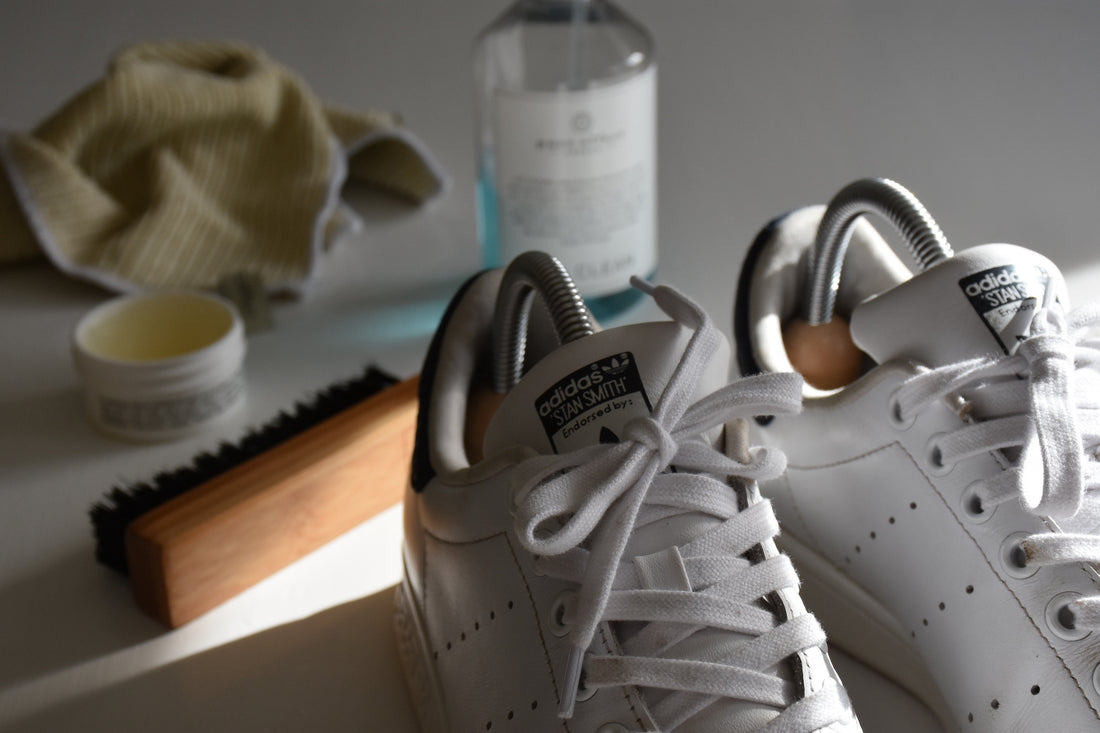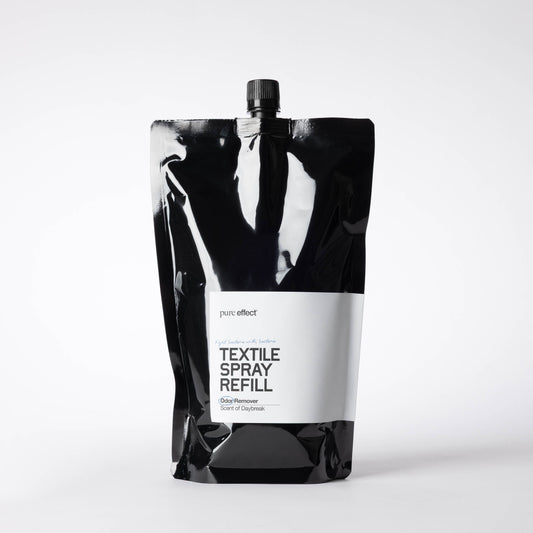
Why do your sneakers and active-wear smell bad?
Sweat does not smell - in its original form. It is only when bacteria on the skin start breaking down the sweat that odor occurs. The fight against the smell of sweat has become a billion-dollar industry based on our fear of smelling bad. Let's take a closer look at what sweat is and how the smell arises.
The problem occurs on the skin, the interface where the human body meets the microorganisms in the environment. Several factors influence the end result: human genetics, the microbial ecosystem that colonizes the body, and also microbial genetics - the tools that microorganisms have at their disposal to break down the nutrients in sweat.
Odor, in turn, can be explained by biochemistry. Odors are made up of molecules suspended in the air. Some of them are perceived as very unpleasant, even in very small amounts. When sweat smells bad, it is because odorless molecules have been broken down by microorganisms and converted into smelly substances - often volatile fatty acids or substances containing sulphur.
MICROORGANISMS - A CARPET OF LIFE THAT COVERS EVERYTHING
Microorganisms are very small, single-celled life forms. Because they are invisible to the naked eye, we need tools to record them at all. Until recently, our scientific tools have only allowed us to study those organisms that could be (successfully) grown in a laboratory. We have therefore thought that these were the only ones that existed.
But rapid scientific and technological developments have made it possible to read the genetic code of all organisms in a given environment - without the need for successful cultivation in the laboratory. Metagenomics has provided a revolutionary insight: we are in fact surrounded by huge numbers of microorganisms we never knew existed; a biological 'dark matter' that completely dominates the planet.
We now know that less than one percent of all life forms present in a random sample - from any environment - are those that can be grown. Without the new technology, these would have remained invisible. Now we also know that the visible world - plants, animals, fungi - is a vanishingly small part of life on Earth. The real diversity and richness of species is out of sight, in the world of microorganisms.
Microbial ecosystems
Microbial ecology is the study of the interaction between living microorganisms and their environment. Microorganisms create microscopic ecosystems, which are governed by the same laws as any other ecosystem on Earth. Which species thrive, benefit or suffer is determined by the resources available. Natural selection also occurs at the microscopic level. Microorganisms interact, compete and fight each other. They break down substances together, step by step, cooperatively, forming networks of interdependencies.
A microbial ecosystem establishes itself rapidly in all environments and under all possible conditions. Microorganisms are everywhere, always, and cover every surface on Earth. This of course also applies to the human body - both inside and outside.
The unknown biomass of the body - the microbiome
It is only relatively recently - in the 21st century - that we have become aware of the billions of single-celled organisms living in and on the human body. In fact, every human being lives in symbiosis with a species-rich biomass consisting mainly of bacteria - our microbiome. The vast majority of these live in the large intestine (a colony commonly referred to as the microbiota) and perform a variety of vital tasks.
The healthy human body is completely dependent on bacteria to ensure the normal functioning of many of its systems - in particular the immune system. Many disease states are characterized by clear changes and abnormalities in bacterial populations. Different species increase or decrease, or their ratio shifts.
Even the outside of the body is protected by allied microorganisms. They colonize the skin, prevent disease-causing microorganisms from gaining a foothold and secrete acidic substances that lower the pH. A more acidic environment inhibits the growth of unwanted bacteria. But they also secrete anti-microbial substances in order to eliminate their competitors through chemical warfare.
The body is like a vast continent with a variety of environments. Microbial ecosystems therefore also vary with the conditions of the place. For example, the bacteria living in the mouth and nose are completely different from those living on the scalp. The conditions under the arms are unique. This skin surface is therefore home to a very specific set of microorganisms. And they are numerous: an armpit is home to as many single-celled organisms as there are people on the planet - at least.
These microorganisms and the environment combine to create the familiar problem we are constantly fighting: the smell of sweat.
The skin interface
Sweat odor occurs when sweat meets the microorganisms in the environment. Both of these factors also contribute to the fact that the smell of sweat varies from person to person. First, each person's sweat is unique in its composition and quantity. Secondly, each person has a personal microbiome.
Metagenomics has of course made it possible to map the specialized ecosystem that normally inhabits the skin surface of the human armpit. It has been found that it varies from person to person, but within certain limits: a few bacterial families and their subspecies recur frequently, but in different proportions. Some microorganisms - mainly from the Propionibacterium, Staphylococcus and especially Corynebacterium families - produce a distinct, unmistakable and unpleasant smell. And they do so because sweat contains nutritious molecules that they can break down in their metabolism.
Two types of sweat glands
Humans have two different systems for producing sweat, and two different types of sweat glands associated with each system.
By far the largest number of sweat glands are merocrine. They are controlled by the neurotransmitter acetylcholine, from the hypothalamus in the brain, which registers and controls body temperature. When the body temperature rises, large amounts of sweat are produced, consisting mostly of water and salts. These sweat glands are found almost all over the body, especially on the hands and feet. The function of the merocrine sweat glands is mainly temperature regulation, but sweating can also be triggered by stress and nervousness.
Underarm sweat, on the other hand, is produced by apocrine sweat glands. They become active during puberty and discharge around the hairs. This sweat has a different composition. It is milky, oily and full of lipids (fats), proteins and carbohydrates. This is excellent nutrition for the resilient bacteria that have made this place their habitat, and which seem to resist all our attempts to eradicate them. Sweating is controlled by norepinephrine, a neurotransmitter and blood-borne hormone, and is influenced by emotion and touch.
Biochemistry - some molecules smell worse than others
So what does the bad smell consist of? The answer is: mainly short, volatile fatty acids that result when odourless lipids are broken down by microorganisms. Another source of discomfort is substances containing sulphur - nature's best bet for producing truly repulsive odours. This type of smell is produced naturally by the decay and decomposition of organic matter, but can also be produced intentionally. An example of this is the skunk's defense mechanism, but examples also exist in the plant kingdom: nauseating odors can be produced by flowers that want to imitate the smell of rotting flesh in order to attract and be pollinated by flies.
Sulphur is found in proteins (and their building blocks amino acids) secreted in the sweat of the mesocrine sweat glands. When these larger molecules are broken down by microorganisms, the end result is smaller, volatile, sulphur-containing molecules - and humans have a highly developed ability to detect the presence of these substances even at very low concentrations.
GENETIC BACKGROUND
Genetics control sweating
Human sweat is controlled by underlying genetic factors. They determine, for example, how many sweat glands you have, how they are distributed across the body and the composition of your sweat. Not all people's sweat is identical. The composition of men's sweat is different from women's, which means that men's sweat smells different and is also stronger. For example, steroids are present in male sweat - nourishing another category of bacteria, and thus adding another ingredient to the sweat odor cocktail of malodorous substances.
The smell of sweat also depends on a person's age, as it is also controlled by hormones that change throughout life. Europeans and Africans sweat in a similar way, while Asians have a genetic variant that makes their sweat significantly less smelly.
Microbial genetics, enzymes and metabolic pathways
Since odor is the result of the breakdown of microorganisms, it is also interesting to map out what actually happens when the lipids, proteins and carbohydrates in sweat are transformed from 'raw materials' into smelly metabolites.
The possible degradation pathways are determined by the enzymes available to the microorganisms present. Enzymes are vital tools that all living beings need for biological processes to take place in their cells. However, enzymes are highly specialized, and a certain specific enzyme is required for a particular reaction to take place. Thus, microbial genetics can reveal what tools a particular bacterium actually has access to - and therefore what it can break down, and into what.
A gene is an instruction that describes how to build a protein, such as an enzyme. If the gene exists, so does the protein, and vice versa. If the protein is present in a bacterium, the bacterium will also be able to perform certain predetermined reactions along a degradation pathway. In this way, we can find out which bacteria are responsible for which odor, and why.
ODOR, THE FUTURE AND RESEARCH
Daily routines in the bathroom
The fight against bad smells is a billion-dollar industry, whose value is increasing as we become more sensitive to 'natural' smells - and more intolerant of expressions of unrestrained physicality. It is now socially obligatory to use all available means to avoid bad smells. The most common countermeasures, apart from personal hygiene, are the use of deodorants and antiperspirants. They have the same goal, to control the smell of sweat, but use different agents.
Deodorants work by absorbing bacteria and malodorous molecules. The growth rate of bacteria is reduced by pH-lowering and antimicrobial substances. Odors are masked with fragrances. Antiperspirants instead block the sweat glands and prevent sweating, usually using aluminum chloride. Whatever the method, the effect soon fades and the smell returns.
Bacterial exchange
Since microorganisms play a crucial role in body odor, it is not surprising that attempts are being made to replace the microbial ecosystem that has established itself in the armpits. One of the most interesting experiments involved transplanting an entire ecosystem from a 'sweet-smelling' identical twin to his smelly brother (carried out by Dr. Chris Callewaert, University of California, San Diego). The experiment is said to have been successful and the troubled brother was free of body odour for up to a year.
However, the fact that the fragrant ecosystem established itself after the transplant is probably attributable to the fact that the brothers share the genetics that control their sweating. The bacteria that thrived on one brother could therefore very likely find a home on his identical brother.
'Smart weapons' targeting specific enzymes
At the University of York, a research team led by a molecular biochemist (Dan Bawdon, Ph.D.) in collaboration with the company Unilever has chosen to focus instead on specific enzymes along a metabolic pathway. Through their experiments, they have identified genes in the Staphylococcus family of bacteria that code for enzymes necessary for the production of thioalcohols - sulfur compounds with a particularly unpleasant odor. They now hope that further research will lead to the discovery of a substance that can knock out the ability to convert the components of sweat into thioalcohols.
Can antibacterial sportswear smell more?
The old paradigm of wiping out bacteria across the board has resulted in many sports textiles being treated with antibacterial solutions to reduce odor, such as silver. However, the effect of silver thread material on human skin chemistry and microbiome is largely unknown. A research study of the molecular effect of silver thread clothing on human skin (Melnik, Callawaert, Dorrestein 2023) points to a remarkable impact of the silver thread material on the skin microbiome and chemistry. Unexpectedly, the study showed that the microbial biomass on the skin increased in the majority of the test subjects when wearing silver thread t-shirts. Silver caused an increase in the diversity and abundance of low-abundance bacteria and a decrease in chemical diversity. Relatively small changes in the microbiome produced shifts in molecular composition. This conclusion opens up the scenario that the antibacterial treatments may create the opposite effect - could antibacterially treated textiles even cause more odor than untreated ones? We are following the further research with interest.
Text: Ester Nylöf, writer
Appendix:
The invisible world
How is life on Earth organized nowadays? Until the 1960s, all life forms on Earth were classified as either prokaryotes or eukaryotes. The division into two well-defined domains was based on the presence of the nucleus, i.e. a membrane enclosing the DNA molecule.
Eukaryotes, the domain that includes all multicellular organisms, have a nucleus. Prokaryotes, which all appeared to be bacteria, do not. The bacteria/prokaryotes, in turn, were classified mainly based on their appearance and the way they react with certain chemicals.
In the 1960s, the American scientist Carl Woese began to systematically decipher, using simple and time-consuming methods, the code he believed must be the simplest common denominator of life: ribosomal RNA.
Ribosomal RNA, together with other proteins, forms the ribosome, a structure where the DNA code is 'translated' into chains of amino acids - a fundamental process in all living things. Woese then discovered that there was a group of microorganisms that did not appear to be related to bacteria. The codes were too different. But at the same time, these organisms were both single-celled and lacked a cell nucleus. So they were prokaryotes, but still not related to bacteria.
In fact, he had discovered the third domain - archaea. This revolutionized the way life on Earth is related and organized. Since the 1970s, the Tree of Life officially has three branches: bacteria, eukaryotes and archaea.
Almost all life on Earth is unicellular
All bacteria are single-celled. All archaea are single-celled. Almost all eukaryotes are also single-celled. But among the eukaryotes are life's most fascinating exceptions: large, multicellular organisms - plants, animals and fungi - that is, everything we see around us and think of when we talk about 'life on Earth'.
The strange archaea were first discovered in extreme environments, such as hot sulphur-rich springs. Later, they have been found everywhere from soil samples to the human gut. However, they seem to live completely parallel to our domain. But unlike bacteria, they don't even seem to interact with eukaryotes - and therefore cause no known diseases.




